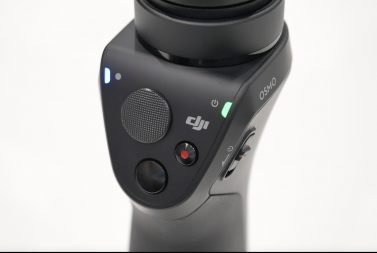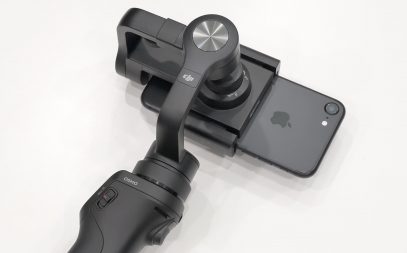
We have reached a point where smartphones have become a primary camera for many, replacing digital point & shoot or even DSLR’s in some situations. Video capabilities built into the devices we carry with everywhere have reached a point that encourages consumers to shoot home videos and creative projects more than ever before, and with the Osmo mobile, DJI is trying to take this to the next level. Although DJI is best known for their drones, they have also recently dominated the professional video industry with their gimbals and stabilizers. Following the release of the first Osmo product which uses an attached DJI camera, the Osmo Mobile achieves the same objective through the use of your smartphone camera.
What’s Included with the DJI Osmo Mobile
Included with the DJI Osmo Mobile Smartphone Gimbal Stabilizer is a 3.5mm cable for charging, a single removable intelligent battery, soft carrying pouch and last a wrist strap. It would have been nice to see a hard-shell carrying case for the gimbal, but the included soft case should be just enough to prevent scratches and chips during transport.
Usability/Modes and Buttons:
The buttons found on the DJI Osmo Mobile includes a central joystick, record button, shutter button, power on/off switch, and a multifunction trigger. The Joystick enables you to navigate the gimbal at a desired angle and direction which I found to be incredibly useful. Additionally, the trigger located on the back locks rotation of the gimbal well being held, while pressing it two times centers the gimbal. Holding the trigger down three times will switch the orientation of the gimbal and smartphone camera through the app, in order to start capturing front facing footage. The buttons were well placed and easy to access during use while allowing you to make adjustments on the go quickly.
Some modes offered on the DJI Osmo Mobile in conjunction with the DJI Go mobile app on your smartphone include Motion time-lapse, long exposure, and panoramas. Motion time-lapse allows you to place the gimbal upright while it smoothly pans during a pre-set period of time to achieve this cinematic time-lapse effect. Long exposure, on the other hand, ensures the camera remains still while trying to capture low-light images effectively. Lastly, panorama mode helps you achieve a wide-angle photo completely handheld through the stabilization and panning features built into the DJI Osmo Mobile.
DJI Go App:
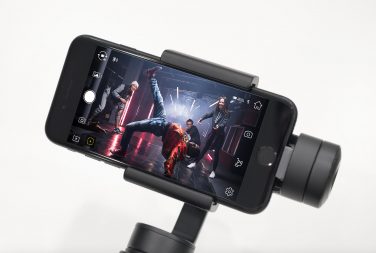 The DJI Go App is the same one used to operate DJI’s lineup of drones. The DJI Osmo Mobile connects to your smartphone via Bluetooth and through the app, you will find basic video assisting tools including grids, resolution settings, manual video settings such as white balance, etc. One of the great features of the Osmo Mobile, however, is Active Track which gives a user the ability to create cinematic parallaxes. This is achieved simply by tracing a box around a static or slow-moving object within the live-view of the DJI GO App, while the gimbal ensures it is tracked and at the center of the frame at all times. Although the gimbal still works standalone, the DJI GO App offers an intuitive user experience while unlocking the full capabilities of the Osmo Mobile.
The DJI Go App is the same one used to operate DJI’s lineup of drones. The DJI Osmo Mobile connects to your smartphone via Bluetooth and through the app, you will find basic video assisting tools including grids, resolution settings, manual video settings such as white balance, etc. One of the great features of the Osmo Mobile, however, is Active Track which gives a user the ability to create cinematic parallaxes. This is achieved simply by tracing a box around a static or slow-moving object within the live-view of the DJI GO App, while the gimbal ensures it is tracked and at the center of the frame at all times. Although the gimbal still works standalone, the DJI GO App offers an intuitive user experience while unlocking the full capabilities of the Osmo Mobile.
Stabilization:
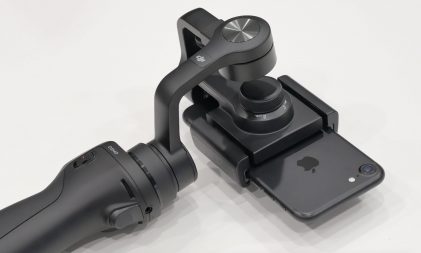 From my testing of the DJI Osmo Mobile with the Apple iPhone 7 I was very much impressed by the results produced. With the iPhone 7 & 7 Plus already having one of the smoothest built-in optical image stabilization for video compared to many other flagship phones I have tested; a gliding cinematic effect still cannot be achieved without a gimbal. DJI has clearly adapted what made their professional gimbal, the Ronin, to a much smaller form factor for a camera that most of us have, a smartphone. As you can see from the footage in my video review, the footage had a cinematic feel to it while the Active Track feature locked onto subjects effectively from my uses.
From my testing of the DJI Osmo Mobile with the Apple iPhone 7 I was very much impressed by the results produced. With the iPhone 7 & 7 Plus already having one of the smoothest built-in optical image stabilization for video compared to many other flagship phones I have tested; a gliding cinematic effect still cannot be achieved without a gimbal. DJI has clearly adapted what made their professional gimbal, the Ronin, to a much smaller form factor for a camera that most of us have, a smartphone. As you can see from the footage in my video review, the footage had a cinematic feel to it while the Active Track feature locked onto subjects effectively from my uses.
All of the footage seen was recorded in my first day of use which comes to show how easy the Osmo Mobile is for anyone to achieve great footage. The only minor issue I encountered initially was a conflict between the built-in optical stabilization within the smartphone, and the gimbal itself.
Build Quality:
Similar to other DJI products, the Osmo Mobile is very well constructed. Its metal construction in the vital parts of the gimbal feels durable, while the rubber grip is comfortable to hold though it starts it feel a bit heavy after an extended period of time (but that’s just me). The clip attached to secure a smartphone is also constructed out of metal at the core and does a great job of locking devices of various sizes through a dial found on the back for adjustments.
Battery Life:
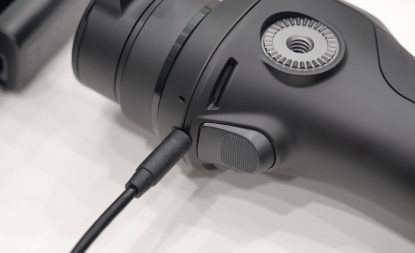 DJI claims a four-hour battery life through the included 980mAH battery (which is removable). Though on paper this is quite a small battery, I was able to get about a day of use while recording footage regularly and remaining on standby throughout the day. Though I appreciate the option to remove/switch out the battery the method of charging is rather unconventional by using a 3.5mm 1AMP option built into the gimbal. A three-hour charge time isn’t too bad, but I would have like to see a more traditional USB charging method.
DJI claims a four-hour battery life through the included 980mAH battery (which is removable). Though on paper this is quite a small battery, I was able to get about a day of use while recording footage regularly and remaining on standby throughout the day. Though I appreciate the option to remove/switch out the battery the method of charging is rather unconventional by using a 3.5mm 1AMP option built into the gimbal. A three-hour charge time isn’t too bad, but I would have like to see a more traditional USB charging method.
Should You Buy the Osmo Mobile
In the market of smartphone gimbals, I strongly believe the DJI Osmo Mobile is the most complete option offered. Aside from the great stabilization abilities, the infrastructure and support that DJI will hopefully use to introduce updates and new features in the future to the gimbal is something that you will not find with many alternatives. With that being said, the price tag is hefty, costing nearly half of an outright flagship smartphone. For many, this will be hard to justify for what it does. But for those who plan to capture smartphone footage regularly for personal or commercial purposes and require the versatility of a mobile device, you will be thoroughly satisfied with your purchase.

